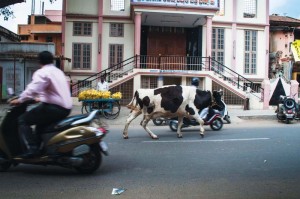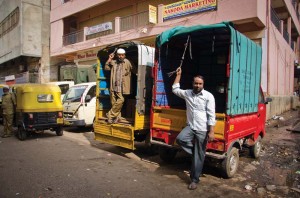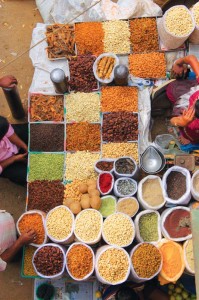Study abroad in India changes photography students’ perspectives on life
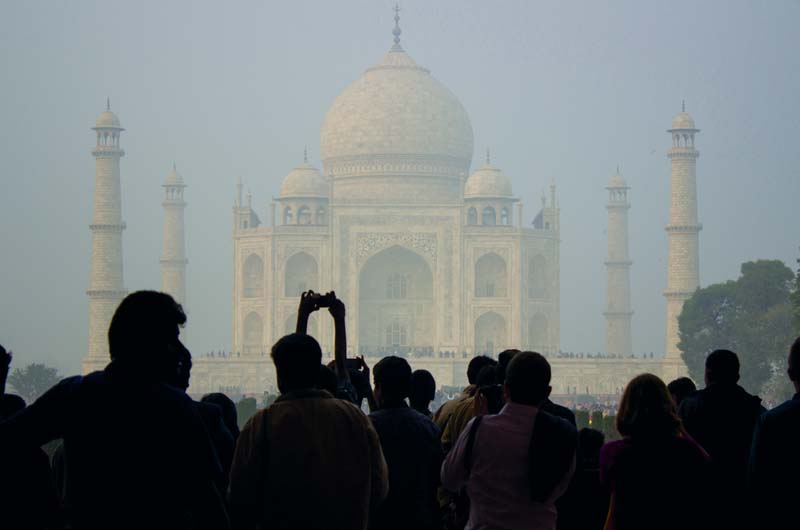
Silhouetted against a fog-enshrouded Taj Mahal, tourists and photographers jockey for position. The monument was built by Mughal emperor Shah Jahan in memory of his third wife, Mumtaz Mahal. Both are entombed there. Photo by Jessica Hamilton ’16.
Laundry flaps from the windows of a train where it has been hung to dry. A dog patiently waits a few feet away from a group of picnickers, hoping for a tidbit or two. Little girls, young mothers, men with weathered faces and shy boys populate the busy streets, back alleys, temples and country- side of a place a world away from central Virginia.
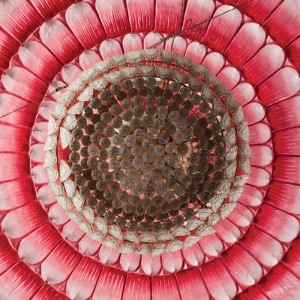
This detail of an elaborate temple ceiling in Bangalore is part of a series of images of temple ceilings created by the photographer, Kelsey Holt ’16.
These scenes are from life off the beaten path in India, a country that, even in its busiest tourist areas, is deeply different from the United States. And yet the 10 Longwood photography students who ventured there—many of whom had never traveled abroad—found themselves feeling oddly at home.
“Everyone reaches out to shake your hand, and, in their calloused hands, you can feel their story,” wrote Eamon Brockenbrough ’15, an art education major from Ashland, in his blog from the course.
“When we arrived in India, everything I expected this place to be turned out to be the entire opposite,” wrote Cara O’Neal ’14 of Warrenton, a photography major. “I was warned to be careful, but they have a very warm culture and are very gracious people.”
O’Neal’s and Brockenbrough’s experiences were typical of the students who signed up for Art 495: Experience India. Led by two Longwood art faculty—assistant professors Michael Mergen and Adam Paulek—the group spent two weeks in India over winter break.
“This experience, seeing India from its jungles to the deserts, has helped to flatten out the world and assist in students’ journeys toward being both artists and citizen leaders,” said Mergen. Though the trip itinerary included the Taj Mahal and a few other well-known attractions, the course was designed to expose the students to the real India as well as to develop their photography skills.
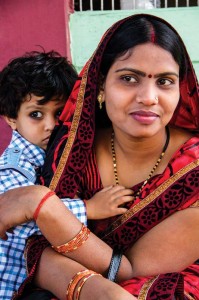
Students on the trip were universally captivated by the people of India, whom they found to be welcoming and generous. Photo by Carson Reeher ’16.
“It’s one thing to know that 1.2 billion people exist in another country on the other side of the world. It’s another thing to see, touch, smell and hear what we might perceive as chaos,” said Paulek. “Most students hadn’t left the country before.
For them, this must have felt like jumping into the deep end of a pool, or more accurately, a deep, swift, filthy, beautiful river.”
The students took hundreds of photographs, the best of which were exhibited in the Bedford Hall Gallery after the trip.
“Simply put, the work is beautiful,” said Mergen. “It goes beyond the surface and really documents a sense of India. As I walked through the gallery, I was most surprised by my inability to identify the locations of so many of the photos. Students saw things and captured them in ways I would have never imagined, let alone seen (in a photographic sense) myself.”
Below are just a few of the images and blog posts from the trip. All of the images, including the cover photo of this magazine, were taken by students. To see and read more from Art 495: Experience India, go to blogs.longwood.edu/india.
And to find out about the many other other study abroad experiences and international aspects of Longwood, see the related story, Four Corners.
Eamon Brockenbrough ’15
I stepped outside of the walls of the temple to explore the mountaintop a little. I found a perch on a wall that overlooked the valley. I sat above the small neighborhood … for a long time, [l]istening to the sounds that echoed out to my perch on the mountain. I could hear everything. A baby crying somewhere for its mother, men conversing in the square, saws working away at lumber, motorcycles accelerating down the street, drills spinning on drywall, chickens clucking in their roost, goats calling out to anyone. … I began to daydream about if I lived in that valley. … On this day I have fallen in love with India, and I’m not sure if I will be able to give it up easily. Before it intrigued me, but sitting alone on that hill and feeling myself work into the fabric of the area, I fell in love. Though no one in that town knew I watched them quietly from a distance, I felt [as if] I could feel each of them.
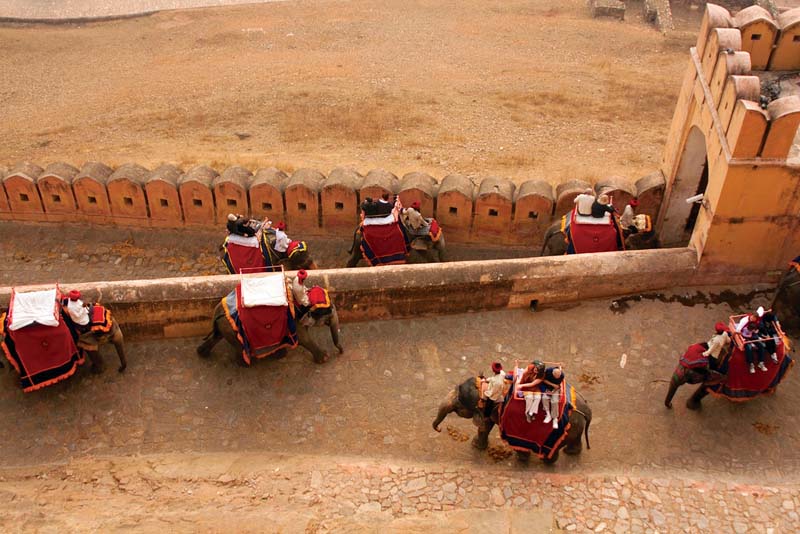
An elephant procession makes its way through the Amber Fort outside Jaipur. Photo by Shelby Wynn ’14.
Kelsey Holt ’14
India is one of those places that never slows down. No matter where I went or what time of day it was, there was always something happening. The shopkeepers would be putting out the goods they hoped to sell. The women would be sweeping the dirt and trash off the streets. Some little old man would be running around yelling, “Chai!” in hopes someone would want a cup. … I found myself taking pictures of almost everything I saw. I wanted to capture every moment. It was when I got some advice to slow down … that I was able to take pictures greater than snapshots. … I started taking notice of the smaller details, the light and interesting spaces instead of getting caught up in the craziness around me.
Caleb Briggs ’14
It was not until my time spent in India that I took notice of men working everyday jobs in marketplaces, train stations and on the streets. … I believe that due to American society’s mindset, I had typically overlooked people working [in] these occupations because it was not glamorous, and we often do not see them as important. India forced me to take a step back from this mindset and observe them, resulting in my seeing a difference between American and Indian culture that I found eye-opening.
Eamon Brockenbrough ’15
Your ears fill up with sounds of car horns, sizzling foods from street vendors, cows mooing as they make their way down the road, men calling out and goats making their presence just as known. And to top it all off— the taste. Every dish of food fills your palate. Flat bread run through sauces of spice and sweetness. None of your senses [is] left untouched.
‘It’s a place where you are forced to surrender all control. … When you do let go, though, that’s when the magic happens.’
Carson Reeher ’16
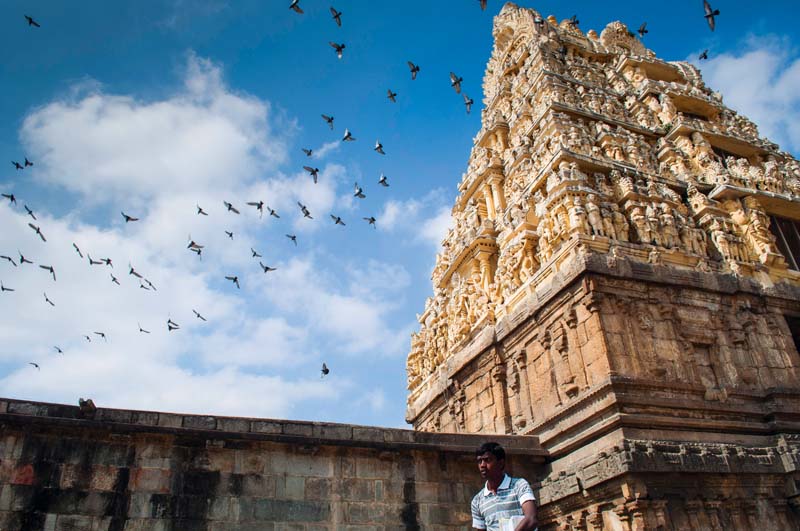
A startled flock of birds punctuates the sky around the Chennakesava Temple in Belur. Photo by Eamon Brockenbrough ’15.
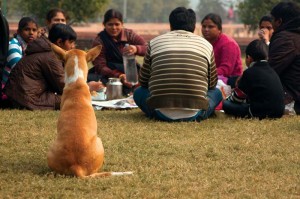
A dog patiently waits for picnickers to finish their lunch, hoping for a few bites of the leftovers. Photo by Shelby Wynn ’14.
Shelby Wynn ’14
I first and foremost noticed the animals. The cows were probably the most noticeable, [followed] … by the dogs that completely took over the cities. I was drawn to the freedom that these animals had and their interactions with everyday Indian life. For the most part, no one owned these animals. They just shared a common respect with the people and were allowed to carry out their lives as they chose. … I really wanted to capture this sense of respect and cohabitation within my images.
Carson Reeher ’16
I don’t consider myself a religious person, but India is a bit of a spiritual experience. It draws in all your senses. It’s a place where you are forced to surrender all control. … When you do let go, though, that’s when the magic happens. India rewards those who are curious. Early morning strolls turn into full-out races; exploring a market ends up with a puja in a temple; a flat tire leads you to [a tour of] a brick factory.
Cara O’Neal ’14
It was a pleasant and often amusing surprise that so many people wanted to meet us, get their photo taken with us or invite us to join in their religious ceremony. It continued to surprise me to see how many Indians were willing to go out of their way to help one another, or to accommodate one of us without expecting anything in return.

A toddler demands the attention of the photographer, who was drawn in not only by her intensity but also by her Disney-logo apparel. Photo by Cara O’Neal ’14.
Eamon Brockenbrough ’15
When wandering through India, almost every person will look cold at first. Their faces still and watching if they are not in discourse with someone else. And they will continue to look this way, watching you, until you make a move. All one has to do is smile and nod at them. As if to say, “I see you, and I understand.” The frozen face always cracks, and a grin widens as they nod back or do the traditional head bob. This is the greeting I have found most often in India. A wide smile that surfaces when provoked by the slightest of gestures. This, to me, represents the people of India.
Student Travelers—Art 495: Experience India
Caleb Briggs ’14, photography major from Charlottesville
Eamon Brockenbrough ’15, art education major from Ashland
Jessica Hamilton ’16, business major from Culpeper
Kelsey Holt ’14, photography major from Richmond
Cara O’Neal ’14, photography major from Warrenton
Emily Poulin ’14, photography major from Chesapeake
Carson Reeher ’16, photography major from Williamsburg
Mary Anna Rose ’14, photography major from Roanoke
Jade Smitherman ’14, visual arts major from Hanover
Shelby Wynn ’14, graphic design/photography major from Salem


